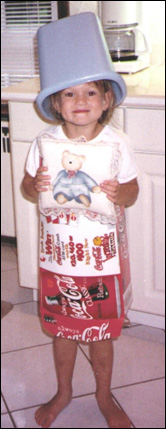Your Child's Vision
 First Eye evaluation between the ages of 1-3.
First Eye evaluation between the ages of 1-3.
As a parent, you strive to help your child develop into a healthy adult. An important part of your child's overall health maintenance program is regular, professional vision care. Your child's eyes must function properly to accomplish the many visual tasks he or she will encounter in the years ahead.
Because you can't look through your child's eyes, it's impossible to accurately judge how well he or she sees. The only way to be sure that vision is developing normally is to make certain your child receives a comprehensive vision analysis by an eye care professional.
Unless a need is identified earlier, your child should be given his or her first comprehensive eye examination between the ages of 1 and 3.
Effective January 2008, it is Illinois law that your child's eyes have to be examined by an eye doctor before entering kindergarten.
Get a real eye examination
Do not confuse a vision screening, a brief check which tests how well a child sees an eye chart from a distance of 20 feet, with a comprehensive examination. Problems with near vision, eye coordination, and focus are among the many problems not identified in just a screening.
Prepare your child for the first examination.
 It is natural for your child to feel some apprehension with a new experience. Talk with your child about the examination prior to the visit. Encourage him or her questions. You can assure your child that the examination is completely painless.
It is natural for your child to feel some apprehension with a new experience. Talk with your child about the examination prior to the visit. Encourage him or her questions. You can assure your child that the examination is completely painless.
With today's diagnostic equipment and tests and our experienced team, your child doesn't need to identify letters, numbers, or even pictures to have his or her eyes examined.
Schedule the appointment for early in the day so that your child will be well rested and cooperative.
To establish a case history, you will be asked a number of questions about your child's general health, development, and symptoms you may have observed. This record will become a valuable reference in evaluating later development.
We will check for several conditions.
There are several problems which could affect your child's vision:
 Astigmatism: A condition in which the vertical and horizontal portions of the eye focus differently, causing blurriness at all distances.
Astigmatism: A condition in which the vertical and horizontal portions of the eye focus differently, causing blurriness at all distances.
Nearsightedness (myopia): a condition in which close objects are seen more clearly than those at a distance. It is often first noticed in the early school years when a child squints to read the chalkboard or holds reading materials closer than normal.
Farsightedness (hyperopia): a condition where far objects are seen more clearly than near ones.
Lazy eye (amblyopia): a condition in which vision cannot be corrected to 20/20 even with eyeglasses or contact lenses. It affects about 2 percent of children. With early diagnosis and treatment, permanent vision loss can be avoided.
Crossed-eyed (strabismus): a condition which occurs when the eyes are not properly aligned with each other. It affects 4 percent of all children.
Is your child having vision problems?
Signs that you or your child's teacher may notice could include:
- Squinting frequently
- Holding a book very close to the eyes -- only seven or eight inches away
- Having a short attention span or frequently daydreaming
- Decreasing scholastic or athletic performance
- Frequently rubbing or blinking the eyes
- Having poor eye/hand coordination
- Avoiding close work
- Complaining about headaches, double vision, or blurred vision
- Covering one eye
- Tilting the head or moving the head back and forth while reading instead of moving the eyes
- Omitting, miscalling, or repeating words when reading aloud
Because your child's eyes can change very rapidly during the early years, it is important to protect his or her vision with regularly scheduled vision examinations by an eye care professional.
Is watching TV bad?
Television viewing habits are an important factor in any discussion of a child's vision. Because television plays a part in almost every child's life, it is essential to develop sensible viewing habits to avoid unnecessary eyestrain. Properly installed and adjusted, televisions and VCRs are safe for the eyes. In fact, more eyestrain can be caused by close activities like reading or sewing than by watching television.
Here are some helpful tips that we recommend to our patients:
- When watching TV, the viewing distance should be at least seven times the width of your TV screen.
- The room should not be completely dark.
- Position the television set so that glare and reflections are avoided.
- Avoid sitting at an extreme angle in relation to the TV screen.
Perhaps most importantly, your child's television viewing should be sensibly balanced with creative play and exercise.

